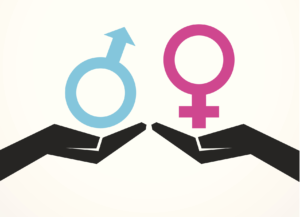When we talk about privilege, we talk about male privilege, white privilege, class privilege, and straight privilege. Sometimes we’ll talk about Christian privilege. Rarely will we talk about cisgender privilege.
But one subject that I haven’t seen addressed enough is ability privilege, and because disability is such a broad category, it’s impossible to create an ability privilege checklist that includes everyone. So instead, I’m writing a walking privilege checklist.
As I’ve begun to prioritize my health, safety, and livelihood by using a wheelchair more and more, I’ve become acutely aware of how wheelchair users are marginalized and how walking privilege shapes our everyday lives.
I still walk probably about 50-60% of the time with various mobility aids, so I recognize that, in part, I benefit from walking privilege myself.
I could compile a separate checklist altogether on how walking privilege affects part-time wheelchair users like myself. But these examples of walking privilege, in no particular order, will ring true for any wheelchair user, whether part or full time:
1. You Can Safely Access Any and All Public Transportation
As someone who doesn’t drive, this is a biggie for me.
I live in New York, and New York City has one of the biggest public transportation systems in the world. You would think it would be accessible, right? Wrong.
Less than a quarter of NYC subway stations are accessible, and most of them are in Manhattan – so good luck if you’re a wheelchair user trying to get to the outer boroughs.
Note that the MTA’s definition of “accessible” is “has an elevator.” Many times, the elevators aren’t working.
And getting onto the subway, while difficult at crowded times for even the most coordinated of people, is something akin to an acrobatic trick for a wheelchair user. I can’t count the number of times my wheels have gotten stuck in between the train and the platform and I’ve had to ask cranky commuters for help.
“But wait!” you say. “What about the buses?”
Well, it’s true that all buses are mandated by law to be accessible to wheelchair users (after decades of fighting by disability rights groups like ADAPT, whose original name was Americans Disabled for Accessible Public Transit).
But often the lifts or ramps don’t work, or drivers simply don’t want to take the extra time to let down the lift or ramp.
Once you’re on the bus, many drivers don’t know how to work the tie-downs to secure a wheelchair, or make it easier on themselves by simply not acknowledging that the tie-downs are there at all. This is extremely dangerous, as your wheelchair can move when the bus moves, even if the chair brakes are on.
2. You Have More Options When It Comes to Finding Housing in Your Price Range
Finding housing for anyone, especially in a big city, is difficult. But for wheelchair users, it can be next to impossible.
Many apartment buildings are not accessible, and bigger, accessible apartments tend to be more expensive.
People with disabilities are disproportionately low income, so the housing situation presents a double whammy to many wheelchair users.
There are programs in place to provide disabled people with low income housing, such as Section 8 in New York City, but this means going through a lengthy application process and being on a waiting list for months, possibly years.
3. You Can Enter Any Bathroom, Enter Any Stall, and Reach Any Fixture
I can’t tell you how many times I’ve rolled all over creation trying to find an accessible bathroom. Even so-called “accessible” stalls are designed to fit the smallest wheelchair possible, making it difficult for those of us with larger chairs or those who need a personal care attendant to help with bathroom needs.
Simple things, like stall-doors that swing in instead of out, can be a challenge if you’re trying to maneuver your wheelchair in the stall. And when I’ve finally done my business, I often have to stretch in order to be able to wash my hands, which leads to a lot of water splashing everywhere.
I’m sure I’m not the only wheelchair user who has taken to carrying around antibacterial hand gel, because accessing the sink is more trouble than it’s worth.
4. You Can Visit Anyone in Their Home (And Can Access Your Own Home)
When I asked my wheelchair-using friends on Facebook to help me come up with examples of walking privilege, this was one of the first examples that came up.
Going over to other people’s houses is part of how we interact with friends, family, and significant others.
For wheelchair users, we usually don’t have the option of interacting with people privately in their own homes.
This means that we’re often forced to have private conversations in public spaces, where other people might overhear. Many wheelchair users can’t even access their own homes. I walk in the house, but I have to keep my wheelchair in the garage because my house has steps.
I know many wheelchair users who are in the same situation, who have much less mobility than me. One girl I know crawls all over her inaccessible house, and got serious infections in her knees because of it.
My best friend’s house has become party central for all our wheelchair-using friends, because her parents redid their entire house to make it accessible when it became clear that their daughter was going to be a lifelong wheelchair user.
Unfortunately, not everyone has that option, due to financial and/or other factors – Our house is a rental, so we can’t do any major renovations.
5. You Can Open Any Door (That’s Not a Metaphor)
Most walking people don’t think twice when opening a door. But if you had to count the number of times in a day you open a door, those numbers would add up.
Opening doors, especially heavy doors to enter restaurants or other businesses, can be tough for a wheelchair user, especially wheelchair users who have limited strength in their arms. Automatic doors can be a godsend, but only if the door buttons are working.
I’m sure anyone who went to college with me can attest to seeing me sitting in front of a building, punching the automatic door button repeatedly, and yelling “WHY WON’T YOU OPEN???” on almost a daily basis.
There are people who walk who have limited strength in their arms, who have trouble opening doors, but opening doors from a seated position makes it even more difficult.
6. Your Means of Daily Mobility Isn’t Touched, Manipulated, or Leaned On by Strangers
It would be considered creepy and unacceptable for strangers to touch people’s legs without a good reason. Yet, every day I’m confronted by strangers who think it is okay to touch my wheelchair, lean on my wheelchair, or even try and steer my wheelchair in the direction they want me to go.
To you, a wheelchair may look like just a piece of equipment, but to me, it is part of my body. I am as comfortable rolling as you are walking, and my wheelchair gets me where I need to go.
Just because it’s not flesh, that doesn’t give you the right to treat it like something you have the right to touch without my permission.
And that’s not even taking into account that wheelchairs are very expensive and often customized to the user, so if the chair breaks because someone touched it without permission, we’re in trouble.
7. You Can Always Go Through the Same Entrance as Everyone Else
I’ll take “sketchy accessible entrances” for $200, Alex!
Every wheelchair user knows the trials of finding an accessible entrance. Oftentimes the accessible entrance has a locked door, or requires you to take a circuitous route through the kitchen.
This phenomenon isn’t limited to businesses either – I’ve seen it happen with schools and other buildings as well. This de facto segregation is the equivalent of putting a “walking people only” sign over the main entrance.
The other day, I circled a Wendy’s three or four times, trying to find the accessible entrance. When I finally found it, I realized why I hadn’t seen it. It was blocked by a line of cars waiting for the drive-thru, requiring me to cut through said line of cars to get to the curb cut and pray that the drivers saw me and wouldn’t try to move up while I was in the middle.
Risking my life to get that homestyle chicken snack wrap is not an uncommon part of my day. I’m sure not many walking people can say the same.
8. You Can Quickly and Safely Get Out of the Building in an Emergency
Everybody has seen those little signs that tell you not to use the elevator in the event of a fire. Few people think about what it actually means for people who can’t use the stairs.
Most places don’t have a policy for wheelchair users in an emergency, and those that do have policies that amount to “sit at the top of the stairs or in a designated ‘safe room’ until someone comes to get you.”
Pssst…no one ever comes to get you.
I have personally sat in “safe rooms,” feeling decidedly unsafe, wondering if this was just a drill or if I was about to burn to death.
And if you can get down the stairs somewhat, like me, or if you enlist someone to carry you down the stairs, you’re faced with leaving your very personal, very expensive wheelchair and your means of moving around inside a possibly burning building, not to mention rising severe injury by trying to get downstairs in a crush of people who can all move faster than you.
Die in the fire, or die being trampled trying to escape! There’s really no option that doesn’t end in death here.
9. You Can See People Who Move Like You Being Represented in a Positive Light in Media
TV, magazines, books, movies, advertisements – walking people are everywhere! You know how often I look at any type of media and see a wheelchair user?
Almost never.
And when I do, they’re represented as bitter, angry, pitiful, evil, and/or desperately searching for a way to walk.
Check out the TV Tropes disability page if you don’t believe me. Jake Sully from Avatar? Bitter and finds a way to walk by hooking himself into a virtual reality machine to become a big blue alien. Davros from Doctor Who? Evil creator of the Daleks. I could go on and on.
I rarely see wheelchair users in media who are presented as three-dimensional human beings, just like any other person. Luckily, that’s starting to change. Target had a fantastic back to school commercial this year that included a boy using a sporty manual wheelchair as just part of the group.
I sincerely hope that other advertisers and other media will follow Target’s example.
10. Your Entire Being Isn’t Defined by Your Means of Mobility
I was sitting on an Amtrak train at Penn Station once, waiting for a redcap to come and put the bridge plate down so that I could get off the train. Two women were behind me, talking, and I heard one of them say “I don’t know if they have to let the wheelchair off first.”
This wasn’t the first time I’d been called a wheelchair, nor would it be the last – but it’s one of the instances that sticks out most clearly in my mind, mainly because I was RIGHT THERE.
Do I call walking people “legs?” Of course not! So then why is it acceptable for people to call me “wheelchair?”
I have a name, which no one ever bothers to learn. The crossing guards at college spent nearly three years calling me “Wheels” before they thought to ask my name.
I would even settle for being called “the girl in the wheelchair,” even though I prefer the term “wheelchair-user.”
I love my wheelchair, and I have no shame in my disability. And truth be told, it does define me, somewhat.
But to boil my entire being down to “wheelchair” is not only rude, it’s downright wrong. My best friend has an incredible blog post about being called “wheelchair” that everyone, walking or not, should read.
***
One of the arguments that I hear often when it comes to dissecting privilege and oppression goes something like this: “That’s not privilege! That’s just the way the world is! You just want special treatment!”
Ironically, this type of statement only serves to prove that privilege exists. Privilege is being able to say “That’s just the way the world is,” and not see a problem with it.
The world doesn’t have to be this way. We can structure the world so it’s more accessible for everyone, not just disabled people.
As for special treatment, “special” implies something extra. We don’t want anything extra. We just want equality. We want justice.
Until I can say with absolute truth that this checklist is completely obsolete, we have not achieved equality. It’s a long road, but I think we can make it there.
[do_widget id=’text-101′]
Cara Liebowitz is a Contributing Writer for Everyday Feminism. She is a multiply-disabled activist and writer currently pursuing her M.A in Disability Studies at the CUNY School of Professional Studies in Manhattan. Her published work includes pieces in Empowering Leadership: A Systems Change Guide for Autistic College Students and Those with Other Disabilities, published by the Autistic Self Advocacy Network, and the Criptiques anthology. Cara blogs about disability issues large and small at That Crazy Crippled Chick. You can check her out on Twitter @spazgirl11.
Search our 3000+ articles!
Read our articles about:
Our online racial justice training
Used by hundreds of universities, non-profits, and businesses.
Click to learn more





















